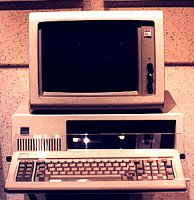
We'll make it easy for you. Let's define personal computer as a computer having the following attributes:
|
|
Ready?
| Bzzzt! The IBM PC was introduced in 1981. It was perhaps the first to wear the "PC" label, but that was IBM's only innovation. They sure sold a bunch of them, though. |

|
| Make | Model | Introduced | Price | Technology | Form |
| IBM | 5150 PC | 1981 | ? | 8088/VLSI | desktop |
|
No, the 1977 Apple ][ was the first highly successful mass-produced personal
computer, but not the first personal computer. Nor was the 1976 Apple 1, which
can be considered an Apple ][ prototype since only 200 or so were made.
The Apple 1 signaled the end of toggle switches and blinkenlights, and launched the interactive graphical microcomputer as a new class of machine. |
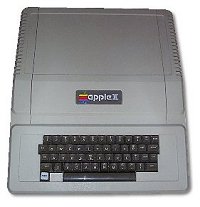
|
| Make | Model | Introduced | Price | Technology | Form |
| Apple | Apple ][ | April 1977 | $1295 | 6502/LSI | desktop |
| Apple | Apple 1 | May 1976 | $666 | 6502/LSI | single-board |
Good answer! But no, the IBM 5100, introduced in September 1975, was IBM's first
personal computer, but it was priced too high for most people to have
considered. Pricing was as follows:
The 5100 was just one of several personal computers IBM made before the PC. It was followed by the 5110, the 5120, the Datamaster, and then finally the 5150 PC. |
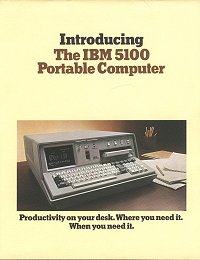
|
| Make | Model | Introduced | Price | Technology | Form |
| IBM | 5100 portable Computer | September 1975 | $9000-$20,000 | LSI | portable all-in-one |
| IBM | 5110 | 1978 | ? | LSI? | portable all-in-one |
| IBM | 5120 | 1980 | ? | LSI? | all-in-one with build-in 8" floppies |
| IBM | Datamaster | 1981 | ? | LSI/8085 | all-in-one with build-in 8" floppies |
|
You're way off! The Altair, introduced in January 1975, was the first computer to be produced in
fairly high quantity, and it was the first computer to run Microsoft
software, but we're not sure that's a good thing.
Unfortunately for computer history buffs, the Altair is often mistakenly called the first personal computer by Microsoft-loving journalists who don't know any better. |
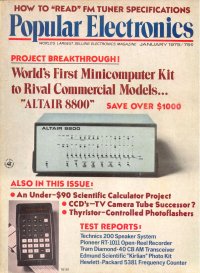
|
| Make | Model | Introduced | Price | Technology | Form |
| MITS | Altair 8800 | January 1975 | $439 for kit, $621 assembled | 8080/LSI | S-100 desktop box |
|
Nope, but the Mark-8 (1974) was the first microcomputer kit with plans published
in a popular magazine. The Mark-8 provided the first big spark that catalyzed
the hobbyist movement.
Before the Mark-8 appeared, there was at least one hobbyist newsletter, the ACS Newsletter, published by the Amateur Computer Society, which focused primiarily on the PDP-8, the machine which inspired the Mark-8. The Mark-8 spawned a few more hobbyist newsletters, such as Hal Singer's Micro-8 and Hal Chamberlin's The Computer Hobbyist. The machine was designed by Jon Titus. |
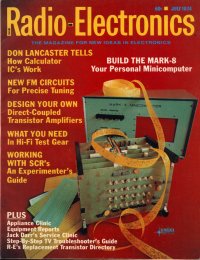
|
| Make | Model | Introduced | Price | Technology | Form |
| Radio Electronics | Mark-8 | July 1974 | $5 for assembly plans | 8008/LSI | desktop kit |
|
No, but the Scelbi-8H (1973) was another microcomputer that preceded the
Altair. Like the Altair, it was available from the manufacturer both as
a kit and as a pre-assembled computer.
The machine was designed by Nat Wadsworth. |
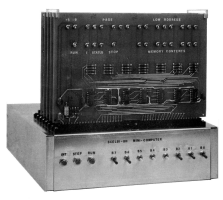
|
| Make | Model | Introduced | Price | Technology | Form |
| Scelbi | 8H | 1973 | $565 | 8008/LSI | desktop |
| No. Some people consider the HP 65, introduced in 1973, a mere calculator, but it was fully programmable; you could even play games on it. HP even called it a personal computer in their introductory article in the HP Journal, but it wasn't the first. |
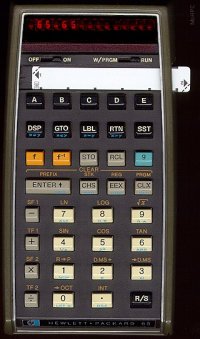
|
| Make | Model | Introduced | Price | Technology | Form |
| Hewlett Packard | 65 | 1973 | $795 | LSI | handheld |
| You're getting warmer. The Alto, introduced in 1973, but never commercially produced, was perhaps the most innovative design in computer history: it had a mouse, a GUI, an object-oriented OS and development tools, and fast networking with the first ethernet cards. These are features that wouldn't be common until 10 years later, and even 20 years later some of them were still cutting edge. |
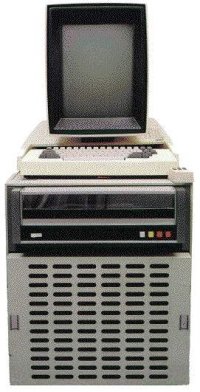
|
| Make | Model | Introduced | Price | Technology | Form |
| Xerox | Alto | April 1973 | N/A | MSI | workstation |
It has also been said that the Micral is the earliest non-kit microcomputer. This might be true only in a very narrow sense. Intel themselves made earlier microcomputers, such as the SIM4 and Intellec-4, and Intel advertises design wins such as the Seiko S-500 desktop computer as early as March 1973.
| Make | Model | Introduced | Price | Technology | Form |
| Micral | Micral | 1973 | $1750 | 8008/LSI | desktop |
|
The Intel MCS-4-based SIM4 (1972) was the first microcomputer, but not the first
personal computer.
The single-board SIM4-02 is shown at the right plugged into an Intel MCB4 chassis along with a PROM programmer card. (The machine belongs to Dwight Elvey, and the photo was taken by Doug Coward.) |
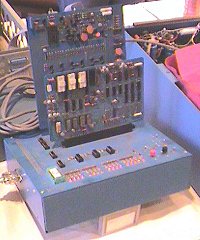
|
| Make | Model | Introduced | Price | Technology | Form |
| Intel | SIM4-01 | 1972 | ? | 4004/LSI | single-board |
|
Good guess! The HP 9830, introduced in 1972, was the first desktop
all-in-one computer. It even had BASIC in ROM, but few people know
about it because HP marketed it primarily to scientists and engineers,
very quiet people.
Even earlier (1968), HP produced a similar desktop machine called the 9100. However, since it didn't have a full alphanumeric keyboard or display, it is generally considered a sophisticated programmable calculator rather than a general-purpose computer. According to one researcher, the term personal computer was first used to describe the 9100A. |
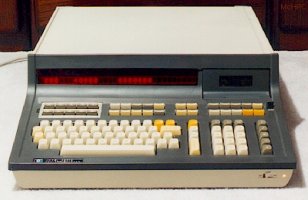
|
| Make | Model | Introduced | Price | Technology | Form |
| Hewlett Packard | 9830A | 1972 | $5975 | MSI | desktop all-in-one |
| Make | Model | Introduced | Price | Technology | Form |
| Kenbak | Kenbak-1 | 1971 | $750 | MSI | desktop |
| Make | Model | Introduced | Price | Technology | Form |
| Imlac | PDS-1 | 1970 | ? | SSI, core memory | workstation |
|
I don't think so. The "paperclip computer" was introduced in 1967
in a book called How To Build a Working Digital Computer by
Alcosser, Phillips, and Wolk. The book describes how you can build
a simple computer with things around the house, like paperclips for
switches, and a tin can for drum memory.
In 1969, a company called COMSPACE created a "professional" version of this computer called the Arkay CT-650. |
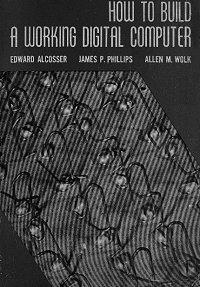
|
| Make | Model | Introduced | Price | Technology | Form |
| Alcosser, Phillips, and Wolk | Paperclip Computer | 1967 | $3.75 + parts | paperclips, tin can, knife switches | desktop |
| COMSPACE | Arkay CT-650 | 1969 | $1000 | relay | desktop |
|
He he! Stop; you're killing me! Incredibly, around 1966 Honeywell tried to
enter the home computer market with the Kitchen Computer. Cutting board
included!
The same computer, sans cutting board, was used by BBN to build the IMP's that powered the ARPANET.
|

|
| Make | Model | Introduced | Price | Technology | Form |
| Honeywell | Kitchen Computer (based on DDP-516) | 1966 | $7000 | SSI, core memory | appliance |
| Make | Model | Introduced | Price | Technology | Form |
| DEC | PDP-8 | 1965 | ? | SSI, core memory | desktop |
| Make | Model | Introduced | Price | Technology | Form |
| Scientific Development Corporation | Minivac 601 | 1961 | $135 | relay | desktop |
| Almost! The EC-1, introduced in 1959, was a small inexpensive desktop computer. It was available as a kit for under $200! But it wasn't digital. It was analog, and could be used to solve certain types of problems, but it's not what most people think of as a computer today. |
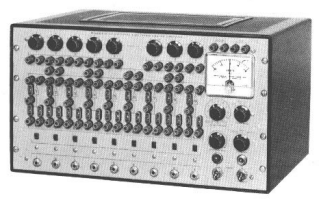
|
| Make | Model | Introduced | Price | Technology | Form |
| Heathkit | EC-1 | 1959 | $199 | analog tubes | desktop |
| Make | Model | Introduced | Price | Technology | Form |
| Berkeley Enterprises | GENIAC | 1955 | $19.95 | electric rotary switches | single-board |
|
BINGO! Edmund Berkeley first described Simon in his 1949 book, "Giant
Brains, or Machines That Think" and went on to publish plans to build
Simon in a series of Radio Electronics issues in 1950 and 1951.
Simon touched such pioneering computer scientists as Ivan Sutherland, who went on to influence development of interactive graphical personal computers. By 1959, over 400 Simon plans were sold. |
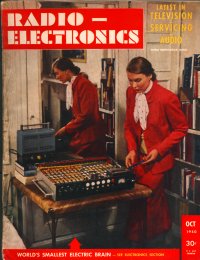
|
| Make | Model | Introduced | Price | Technology | Form |
| Berkeley Enterprises | Simon | 1950 | about $300 | relay | desktop |